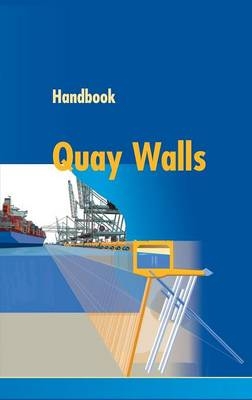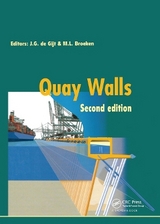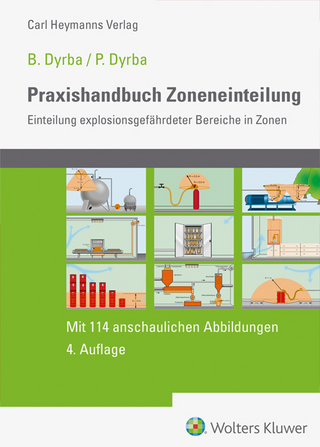
Handbook of Quay Walls
Taylor & Francis Ltd (Verlag)
978-0-415-36439-3 (ISBN)
- Titel erscheint in neuer Auflage
- Artikel merken
Essential knowledge for the planning, design, execution and maintenance of quay walls, plus general information about historic developments and lessons gained from observation of ports in various countries. Technical chapters are followed by a detailed calculation of a quay wall, based on semi-probabilistic design procedure, which applies the theory presented earlier. Quay Walls will interest anyone involved in the design, construction and use of quay walls, including designers, contractors, engineers, operators and managers. It also provides a rich source of basic information for students and professionals.
CUR is an independent non-profit organisation, based in the Netherlands, which works for the development, acquisition and transfer of knowledge and experience in the areas of construction, civil engineering and urban & rural planning. CUR initiates and co-ordinates joint research projects with both public bodies and private companies. The results are disseminated through the publication of reports, recommendations and codes of practice as well as through the organisation of seminars and other meetings.
Summary
Chapter 1 Introduction
1.1 Function of quay walls
1.2 Objective of this handbook
1.3 Layout of the handbook
Chapter 2 History of quay wall construction
2.1 Ports as a source of prosperity
2.2 Ports and quays past and present
2.3 History of quay wall construction in Rotterdam
Chapter 3 Main types of quay wall
3.1 Functions and main types of quay walls
3.2 Gravity walls
3.3 Sheet pile walls
3.4 Sheet pile walls with relieving platform
3.5 Open berth quay
3.6 Examples of gravity walls
3.7 Examples of sheet pile walls
3.8 Examples of walls with relieving platform
3.9 Examples of open berth quays
3.10 Examples of repair or deepening of quay walls
Chapter 4 Site Investigation
4.1 Importance of investigation
4.2 Survey and monitoring plan
4.3 Topographical and hydrographic investigations
4.4 Hydraulic investigations: water levels
4.5 Hydraulic investigations: waves
4.6 Hydraulic investigation: other wave phenomena
4.7 Hydraulic investigations: points of special interest
4.8 Hydraulic investigation: currents
4.9 Investigation into ice loads
4.10 Investigation into meteorological conditions
4.11 Investigations into morphological conditions
4.12 Investigation into nautical boundary conditions
4.13 Investigation into seismic impacts
4.14 Geotechnical and geohydrological investigation: soil investigation plan
4.15 Geotechnical and geohydrological investigations: desktop study, geological maps, groundwater maps
4.16 Geotechnical and geohydrological investigations: site visits, geophysical investigations and site investigations
4.17 Geotechnical and geohydrological investigations: laboratory tests
4.18 Geotechnical and geohydrological investigation: determination of parameters
4.19 Geotechnical and geohydrological investigation: presentation of the results
4.20 Environmental investigation
Chapter 5 Terms of reference
5.1 Terms of reference for design and construction
5.2 Functional terms of reference
5.3 Technical terms of reference
5.4 Detailed explanation
Chapter 6 Design of quay walls
6.1 Design rules
6.2 Functional design aspects
6.3 Structural design aspects
6.4 Features of the constructive design
6.5 Safety philosophy
6.6 Parameters
6.7 Design models and calculation methods
6.8 Calculation and schematizing
Chapter 7 Quay-elements
7.1 Introduction
7.2 Pile foundations
7.3 Sheet pile wall systems
7.4 Anchorages
7.5 Superstructures
7.6 Transitional structures
7.7 Berthing equipment
7.8 Other berth details
7.9 Drainage systems
7.10 Crane tracks and rail structures
7.11 Bottom protection
7.12 Instrumentation for data collection
Chapter 8 Materials
8.1 Concrete and concrete technological aspects
8.2 Steel
8.3 Corrosion
Chapter 9 Construction
9.1 Introduction
9.2 Design
9.3 Construction methods
9.4 Layout of the construction site
9.5 Surveying of the construction site
9.6 Environmental boundary conditions
9.7 Foundation and substructure
9.8 Superstructure
9.9 Fill behind the quay wall
9.10 Dredging
9.11 Scour protection
9.12 Auxiliary structures
9.13 Quality control and quality assurance
9.14 Completion and acceptance of the works
Chapter 10 Costs
10.1 General
10.2 Cost estimate system according to CROW
10.3 Estimation of the construction costs on the basis of indices
10.4 Estimation of the engineering costs
10.5 Risk analysis
Chapter 11 Management and maintenance of quay walls
11.1 From reactive to active management
11.2 The quay wall as a system
11.3 Objectives
11.4 Modelling
11.5 Information
11.6 Assessments
11.7 Measures
11.8 Implementation
11.9 Contribution, conveyance and feedback
Chapter 12 Lessons from experience
12.1 You can’t make an omelette without breaking eggs
12.2 Soil investigations
12.3 Combined walls
12.4 Pile foundations
12.5 Relieving platform
12.6 Anchorage
12.7 Superstructure
12.8 Berthing equipment
12.9 Bottom protection
12.10 Drainage and dewatering
12.11 Deformations of quay structures
12.12 Back fill and dredging
12.13 Earthquake zones
12.14 Working in an aggressive tropical environment
12.15 Quality assurance
12.16 Wise use of the quay
Chapter 13 Future developments
13.1 Introduction
13.2 Port developments
13.3 Ship developments
13.4 Development of logistic concepts
13.5 Development of new quay concepts
Chapter 14 Bibliography, standards, websites
14.1 Bibliography
14.2 Standards
14.3 WebsitesAnnex
Annex A Checklist technical terms of reference
Annex B Explanation of the safety considerations for the
sheet pile wall in a quay structure
Annex C Determination of the design value for normative differences in piezometric head over a quay structure
Annex D Calculation example for a quay wall with a relieving platform
Annex E Contract and conveyance of works
Annex F Glossary of terms and abbreviations used
Nomenclature; Addresses of sponsors and advertisers; Acknowledgement of photographs; Index.
| Erscheint lt. Verlag | 12.9.2005 |
|---|---|
| Verlagsort | London |
| Sprache | englisch |
| Maße | 156 x 234 mm |
| Gewicht | 1202 g |
| Themenwelt | Technik |
| ISBN-10 | 0-415-36439-6 / 0415364396 |
| ISBN-13 | 978-0-415-36439-3 / 9780415364393 |
| Zustand | Neuware |
| Informationen gemäß Produktsicherheitsverordnung (GPSR) | |
| Haben Sie eine Frage zum Produkt? |
aus dem Bereich



